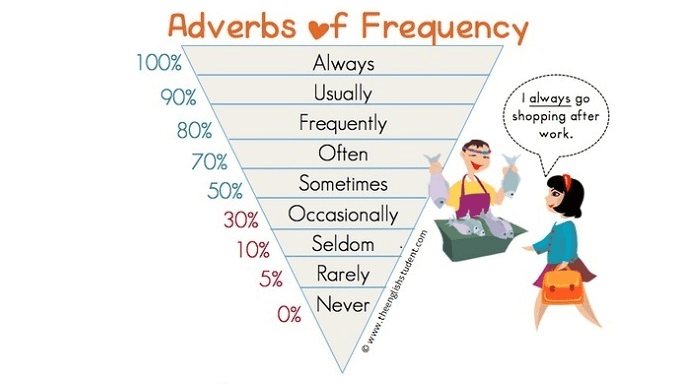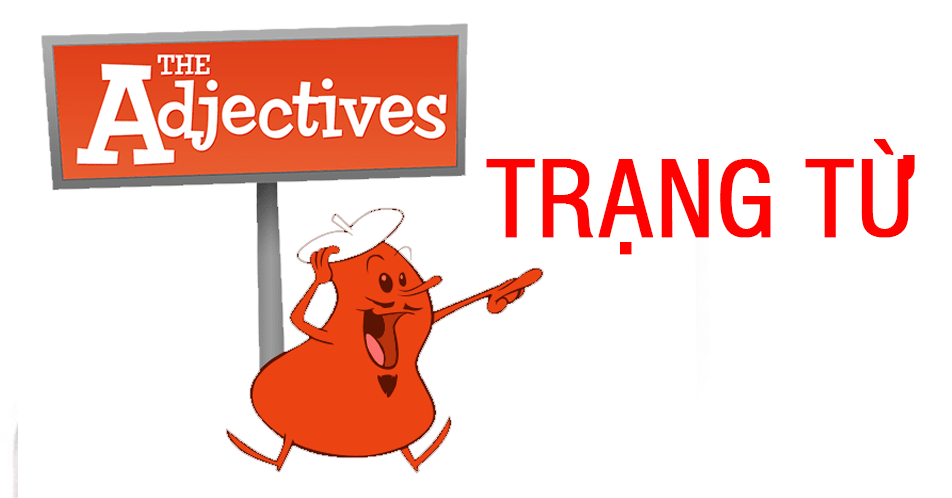Trạng từ (hay còn gọi là phó từ) trong tiếng Anh gọi là adverb. Là loại từ quen thuộc mà bất kể bạn học tiếng Anh mà cũng cần phải nắm rõ và sử dụng thành thạo.
Trạng từ là những từ dùng để bổ nghĩa cho động từ, tính từ, một trạng từ khác hay cho cả câu. Trạng từ thường đứng trước từ hay mệnh đề mà nó cần bổ nghĩa. Nhưng cũng tùy trường hợp câu nói mà người ta có thể đặt nó đứng sau hay cuối câu nên vẫn gây nhầm lẫn vì có nhiều cách sử dụng khác nhau. Bài viết hôm nay sẽ chia sẻ về Bài tập về Trạng từ trong tiếng Anh có hướng dẫn đáp án chi tiết.
1. Trạng từ là gì? Dấu hiệu nhận biết
Adverbs- trạng từ hay còn gọi là phó từ, là những từ được sử dụng trong câu để bổ nghĩa cho động từ, tính từ, một trạng từ khác.
- Dấu hiệu nhận biết:
| Adverb endings | Examples |
| l. – ly | firstly, fully, greatly, happily, hourly |
| 2. – wise | otherwise, clockwise |
| 3. – ward | backward, inward, onward, eastward |
2. Cách sử dụng trạng từ

| Vị trí | Ví dụ |
| Sau V thường | He drove carefully. |
| Trước Adj | I meet an extremely handsome man |
| Giữa cụm V | She has already finished the job |
| Đầu câu hoặc trước dấu phẩy | Unfortunately, I couldn’t come to the party. |
| Sau too V + too + adv | They walked too slowly to catch the bus. |
| Trong cấu trúc V + so + adv + that | Jack drove so fast that he caused an accident. |
| Trước enough V + adv + enough | You should write clearly enough for everybody to read. |
Ví dụ:
- Bổ nghĩa cho động từ: Can you move it carefully? it’s fragile. ( Bạn có thể di chuyển nó cẩn thận chút được không. Nó rất dễ vỡ).
- Bổ nghĩa cho tính từ: The place was strangely quiet. ( Nơi đây yên ắng đến lạ lùng).
- Bổ nghĩa cho trạng từ khác: We’ll meet shortly afterward. (Sau này chúng ta sẽ gặp nhau ít hơn).
3. Phân loại các loại trạng từ
Theo chức năng, trạng từ được chia thành 7 loại chính
3.1. Trạng từ chỉ cách thức
Đây là loại trạng từ rất phổ biến trong tiếng Anh. Trạng từ cách thức được hình thành bằng cách thêm đuôi “ly” đằng sau tính từ.
Ví dụ: Exclusive – Exclusively; Recent – Recently; Beautiful – Beautifully,…
Cách dùng: Diễn tả cách thức hành động xảy ra như thế nào.
Vị trí: giữa hoặc cuối câu, nếu đứng giữa câu, trạng từ chỉ cách thức thường đứng sau động từ hoặc sau tân ngữ.
Ví dụ: He can speak French fluently.
Tuy nhiên có một trường hợp ngoại lệ:
| Tính từ | Trạng từ |
| fast | fast |
| hard | hard |
| late | late |
| good | well |
| fair | fair |
| cheap | cheap |
| early | early |
| much | much |
| little | little |
3.2. Trạng từ chỉ thời gian
Trạng từ thời gian là những trạng từ thường trả lời cho câu hỏi “When”, chỉ thời gian xảy ra hành động.
Ví dụ: yesterday, tomorrow, next year,…
Cách dùng: Diễn tả thời gian, sự việc xảy ra hay được thực hiện, hành động,… .
Vị trí: Thường đứng cuối câu hoặc đầu câu để nhấn mạnh thời gian xảy ra.
Ví dụ: Yesterday, they dropped in my house but I couldn’t remember who they are.
3.3. Trạng từ chỉ tần suất

| Trạng từ tần suất | Nghĩa |
| Always | Luôn luôn |
| Usually | Thường xuyên |
| Normally/ Generally | Thông thường |
| Often | Thường thường |
| Sometimes | Thỉnh thoảng |
| Hardly | Hầu như không bao giờ |
| Rarely | Hiếm khi |
| Never | Không bao giờ |
Cách dùng Trạng từ tần suất: Diễn tả, thể hiện mức độ của chất lượng, sự việc, sự vật, trạng thái, điều kiện, mối quan hệ, …
Vị trí: Thường đứng giữa câu.
Ví dụ: The building was completely destroyed after the earthquake.
3.4. Trạng từ chỉ nơi chốn
Trạng từ chỉ nơi chốn dùng để trả lời cho câu hỏi “Where”.
Ví dụ: here, there, out, away, everywhere, below, along, around, away,…
Cách dùng: diễn tả nơi mà sự vật, sự việc nào đó xảy ra hoặc ở đâu.
Vị trí: Thường được đặt ở giữa câu, ngay sau động từ chính hoặc sau mệnh đề mà nó bổ nghĩa cho.
Ví dụ: Let’s open the box and see what’s inside it/ She goes everywhere with her husband.
3.5. Trạng từ chỉ sự đồng ý
Một số trạng từ thông dụng: quite, too, enormously, almost, just, completely, enough, deeply, virtually, fully, greatly, hardly, terribly, fairly, entirely, practically,….
Cách dùng: Diễn tả, thể hiện mức độ của chất lượng, sự việc, sự vật, trạng thái, điều kiện, mối quan hệ, …
Vị trí: Thường đứng giữa câu.
Ví dụ: The building was completely destroyed after the earthquake.
3.6. Trạng từ đánh giá, ước lượng
Một số trạng từ thông dụng: absolutely, definitely, apparently, clearly, honestly, fortunately, unfortunately, frankly, bravely, carelessly, hopefully, …..
Cách dùng: Dùng để đánh ra, nhận xét, đưa ra quan điểm về một sự việc nào đó, trạng từ ước lượng, đánh giá thường bổ nghĩa cho cả mệnh đề hoặc câu.
Vị trí: Thường đứng đầu hoặc giữa câu.
Ví dụ: Fortunately, they escaped from the fire.
3.7. Trạng từ nối
Một số trạng từ thông dụng: besides, moreover, however, indeed, meanwhile, consequently, furthermore, otherwise, therefore, likewise, thus, additionally, comparatively, finally, next, hence, accordingly,…
Cách dùng: Có chức năng như liên từ, nối hai mệnh đề hoặc câu.
Vị trí: Thường ở đầu câu để liên kết hai câu với nhau hoặc ở giữa câu để liên kết hai mệnh đề.
Ví dụ: The government went through the decision of destroying historic buildings. Consequently, there aren’t any places of interest here.
4. Cách thành lập trạng từ

- Hầu hết các trạng từ đều được cấu tạo từ tính từ thêm “-ly”
Ví dụ: slow- slowly, enormous- enormously, clear- clearly, careful- carefully, annual- annually, hopeful- hopefully, additional- additionally, honest- honestly, ….
Trong một số trường hợp, những từ kết thúc bằng “-ble”, chúng ta thường bỏ “e” trước khi thêm “-ly’.
Ví dụ: true- truly, sensible- sensibly, remarkable- remarkably, horrible- horribly, ….
Nếu tính từ kết thúc là “-y), chúng ta chuyển thành “-” trước khi them “-ly”, trừ một số từ có một âm tiết và kết thúc bằng “-y” như sly, dry,…
Ví dụ: happy- happily, greedy- greedily, sly- slyly, easy- easily, ….
- Một số trạng từ có “-ly” nhưng có thể là tính từ và một số trạng từ có cấu tạo giống như tính từ, do đó có thể khó để tìm và nhận biết trạng từ. Quy tắc dễ nhất là nhìn vào những từ khác đi kèm.
Nếu đứng trước một danh từ, nó có thể là tính từ:
Ví dụ: an early lecture, a late meeting, a short way, a …
Nếu có mối liên hệ đến động từ hoặc đi trước tính từ, nó có thể là trạng từ:
Ví dụ: environmental friendly,
The lesson was cut short.
We met late at night.
She came in early.
Giống như tính từ, trạng từ cũng có dạng so sánh.
Ví dụ: George walked the most slowly of all of them.
The bar chart shows the girls performed the best at maths last year.
- Trạng từ hình thành từ danh từ
Một số ít trạng từ được cấu thành từ danh từ với hậu tố “-wise”, có nghĩa là bằng cách nào, theo cách nào.
Ví dụ: sideways, clockwise, lengthwise, edgewise, crosswise, ….
He hit the tennis ball sideways. “in a way that sent it off to the side of the court”. ( Anh ấy đánh quá bóng tennis sang một bên.- Bằng cách nào đó anh ấy đã đánh quả bóng sang bên lề của sân tennis).
Trong một số trường hợp, trạng từ kết thúc là “-wise” bổ nghĩa cho ý kiến của mệnh đề và nó giới hạn quan điểm của người nói về một ý kiến, phạm vi của chủ đề.
Ví dụ: otherwise, timewise, likewise,… .
It can’t be too windy. Otherwise, the officials postpone the match. Likewise, heavy rain can be a reason for postponing this match.
- Những trường hợp đặc biệt
| Những trạng từ có hình thức không phổ biến | Chuyển nghĩa |
| Với trường hợp này, cấu tạo của tính từ và trạng từ giống nhau hoặc đều kết thúc bằng “-ly” | Trạng từ được cấu tạo từ tính từ có thể có nghĩa khác hoàn toàn với nghĩa của tính từ ban đầu. |
| ● daily- dailyThe magazine is published daily. (adv)This is the daily edition of the magazine. ( adj) | ● hard (tough- cứng)- hardly (barely- hiếm khi)A desk has a hard surface. (adj)I hardly have time to hang out with friends. (adv) |
| ● early- earlyIt is the early edition of the magazine (adj).The magazine arrives early. (adv) | ● late (tardy- muộn, trễ)- lately (recently- gần đây, mới đây)He arrived late at the office. (adj)he hasn’t been working lately. (adv) |
| ● fast- fastShe is a fast runner. (adj)She runs fast. (adv) | ● Free (no cost- miễn phí), freely (without restriction- tự do)Water is free. (adj)You can speak freely. (adv) |
| ● hard- hardIt was a hard problem. (Adj)They play hard. (adv) | ● pretty (beautiful- đẹp)- pretty (rather- hơn)She is a pretty child. (adj)She is pretty difficult to control. (adv) |
5. Các trạng từ đồng nghĩa cần nhớ

- Cẩn thận, kỹ càng: carefully, cautiously, thoroughly, meticulously, elaborately
- Đôi khi: occasionally, sometimes
- Đột ngột: dramatically, suddenly, unexpectedly
- Ban đầu: firstly, initially, primarily, originally
- Thường xuyên: frequently, regularly, usually, often, consistently
- Vô cùng, rất: highly, extremely, very, really
- Hiện tại: currently, recently, lately, already, still
- Khá: relatively, quite
- Đặc biệt, cụ thể: Especially, specifically
- Hoàn toàn: fully (+verb), absolutely (+adj), completely (+adj), extensively (+ verb/adj)
- Hiếm khi: hardly, seldom, scarcely
- Đầy đủ: adequately, sufficiently
- Đã từng, 1 khi: once
- Hợp lý: reasonably
- Lẫn nhau: mutually
- Sớm, ngay: shortly, soon, right after/before, briefly
- Nhanh, lập tức: immediately, promptly, urgently, quickly, swiftly, rapidly
6. Bài tập trạng từ
Bài tập 1.
Bài 1. Find the adjective in the first sentence and fill in the blanks with the corresponding adverb
- James is careful. He drives____________.
- The girl is slow. She walks____________.
- Her English is perfect. She speaks English____________.
- Our teacher is angry. She shouts____________.
- My neighbor is a loudspeaker. He speaks____________.
- He is a bad writer. He writes____________.
- Jane is a nice guitar player. He plays the guitar____________.
- He is a good painter. He paints____________.
- She is a quiet girl. She does her job____________.
- This exercise is easy. You can do it____________.
Đáp án
- James is careful. He drives carefully.
- The girl is slow. She walks slowly.
- Her English is perfect. She speaks English perfectly.
- Our teacher is angry. She shouts angrily.
- My neighbor is a loudspeaker. He speaks loudly.
- He is a bad writer. He writes badly.
- Jane is a nice guitar player. He plays the guitar nicely.
- He is a good painter. He paints well.
- She is a quiet girl. She does her job quietly.
- This exercise is easy. You can do it easily.
Bài tập 2.
Bài 2. Fill in the blanks with suitable adverbs from the box. Write the kind of adverb against each sentence. The same adverb can be used more than once
Occasionally Sometimes Usually Rarely Once Very Never Mostly Often always
- I …………………….. go to bed at 10 o’clock. (…………………………………)
- I have …………………. been to the USA. (…………………………………)
- I have been to Australia just ………………….. (…………………………………)
- I ………………….. take a bath before I go to bed. (…………………………………)
- My grandparents live in Kerala. I visit them …………………… (…………………………………)
- My friends are ………………… non-smokers. (…………………………………)
- I was …………………… impressed with her performance. (…………………………………
- I ………………….. go for a walk in the park. (…………………………………)
- I watch English films …………………. (…………………………………)
- They …………………. go out. (…………………………………)
Đáp án
- I usually go to bed at 10 o’clock. (adverb of frequency)
- I have never been to the USA. (frequency adverb)
- I have been to Australia just once. (frequency)
- I always take a bath before I go to bed. (frequency)
- My grandparents live in Kerala. I visit them often. (frequency)
- My friends are mostly non-smokers. (focusing adverb)
- I was very impressed with her performance. (degree adverb)
- I sometimes go for a walk in the park. (frequency adverb)
- I watch English films occasionally. (frequency adverb)
- They rarely go out. (frequency adverb)
Bài tập 3.
Bài 3. Complete the following with suitable adverbs. Choose from the given box
Almost Very There Ever So Sometimes Clearly Perhaps Seldom Certainly
- I have ………………….. finished.
- He is ………………… clever.
- There is …………………. something wrong.
- ……………….. I think I should take a long break.
- ………………… her train is late.
- He is ……………….. late for work.
- She is ……………….. the right person for the job.
- Have you ………………. wanted to run away?
- You can see lots of flowers ……………….
- They are ………………… beautiful.
Đáp án
- I have almost finished.
- He is very clever.
- There is clearly something wrong.
- I sometimes think I should take a long break.
- Perhaps her train is late.
- He is seldom late for work.
- She is certainly the right person for the job.
- Have you ever wanted to run away?
- You can see lots of flowers there.
- They are very beautiful.
Bài tập 4.
Rewrite the complete sentence using the adverb of frequency in brackets in its correct position
- They go to the movies. (often)
- She listens to classical music. (rarely)
- He reads the newspaper. (sometimes)
- Sara smiles. (never)
- She complains about her husband. (always)
- I drink coffee. (sometimes)
- Frank is ill. (often)
- He feels terrible (usually)
- I go jogging in the morning. (always)
- She helps her daughter with her homework. (never)
- We watch television in the evening. (always)
- I smoke. (never)
- I eat meat. (seldom)
- I eat vegetables and fruit. (always)
Đáp án
- They often go to the movies. (often)
- She rarely listens to classical music. (rarely)
- He sometimes reads the newspaper. (sometimes)
- Sara never smiles. (never)
- She always complains about her husband. (always)
- I sometimes drink coffee. (sometimes)
- Frank often is ill. (often)
- He usually feels terrible (usually)
- I always go jogging in the morning. (always)
- She never helps her daughter with her homework. (never)
- We always watch television in the evening. (always)
- I never smoke. (never)
- I seldom eat meat. (seldom)
- I always eat vegetables and fruits. (always)
Bài tập 5.
Complete the sentence using an adjective or adverb
He’s always in a rush. I don’t understand why he walks so ____________ (quick/quickly).
I prefer studying in the library. It’s always_______________ (quiet/quietly).
Michael __________ (happy/happily) took the assistant job. He had been looking for a position all summer.
Marta dances _____________ (beautiful/beautifully). She’s been taking ballet since she was five years old.
They speak French very ____________ (good/well). They lived in France for two years.
My neighbor always plays ___________ (loud/loudly) music on the weekends. It’s so annoying.
Please be __________ (careful/carefully) in the hallway. The walls have just been painted.
Dan is very smart, but he is not a very___________ (good/well) student.
He reacted __________ (angry/angrily) to the news. I have never seen him so upset.
We didn’t ______________ (complete/completely) understand the teacher’s instructions. Most of us did not finish the assignment.
Đáp án
1. quickly, 2. quiet, 3. happily, 4. beautifully, 5. well, 6. loud, 7. careful, 8. good, 9. angrily, 10. completely
Trên đây là tổng hợp toàn bộ kiến thức quan trọng và đầy đủ nhất về trạng từ trong tiếng Anh. Hy vọng bài viết này sẽ giúp bạn nắm vững ngữ pháp và vận dụng vào bài tập một cách nhuần nhuyễn nhất nhé. Chúc các bạn học tốt.
source https://tienganhduhoc.vn/bai-tap-trang-tu-trong-tieng-anh/
Không có nhận xét nào:
Đăng nhận xét